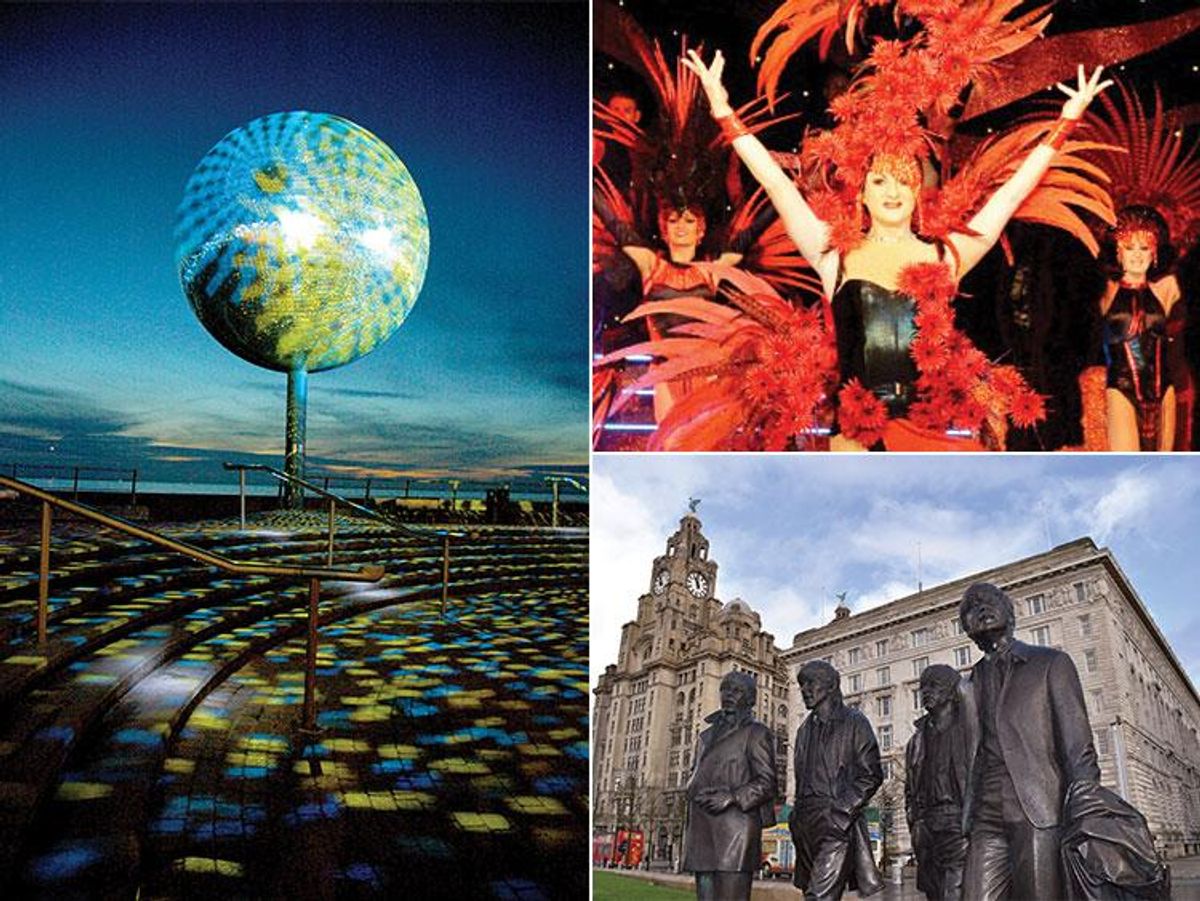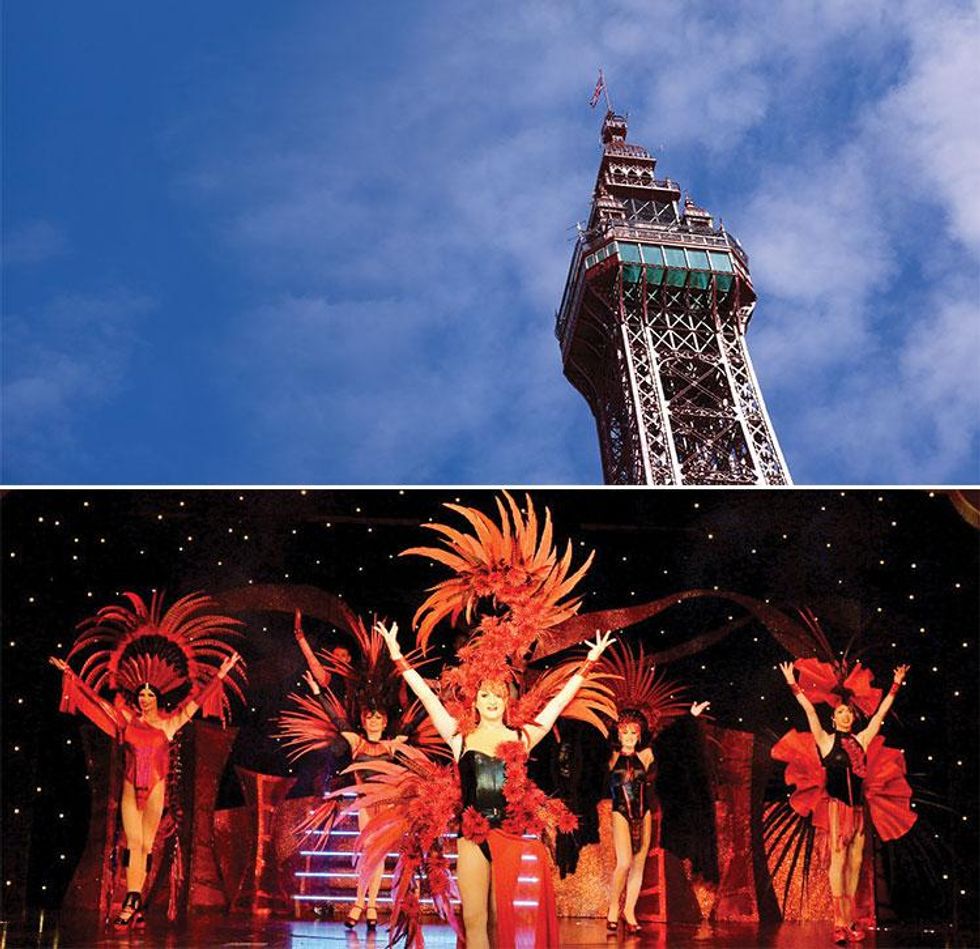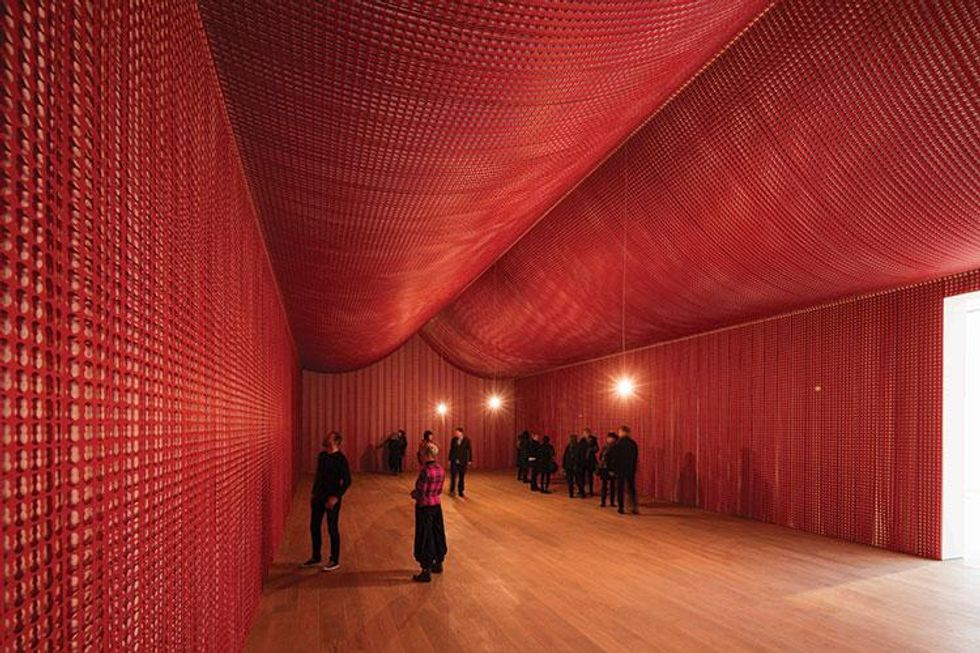Current Issue
Dive into Liverpool, Blackpool, & Manchester

“So, what are you doing here in Blackpool?”
July 01 2016 6:00 AM EST
May 26 2023 2:23 PM EST
By continuing to use our site, you agree to our Private Policy and Terms of Use.

“So, what are you doing here in Blackpool?”
The four men looked at me as if I had just touched down from Mars. With the jet lag creeping in, I suppose I might as well have.
A few minutes earlier, I had decided that my pint of beer required the companionship of a cigarette and headed out to the Funny Girls theater's smoking patio to find one.

Blackpool
Blackpool, a seaside resort town on the northwest coast of England, is one of the most popular vacation spots in the United Kingdom, attracting nearly 10 million visitors annually. As impressive as that figure may be, Blackpool enjoys very little prominence among foreign travelers. So, the matter of how a gay guy from Palm Springs managed to be standing before these men had naturally aroused some curiosity.
Once there, I felt an immediate tug of nostalgia: I was taken back to summer trips with my mom and sister to the Jersey Shore -- not the Jersey Shore forever and inextricably linked to Snooki and friends but a place where both blue-collar and middle-class families could escape to for ocean air, water slides, sunburns, and amusement parks. Yes, there is definitely plenty of fun to be had -- in quite a gay-friendly setting -- for anyone whose idea of a seaside vacation runs more Coney Island than Capri.
Seven miles of beaches form Blackpool's backbone and offer plenty of surf, sand, and salt water during the summer season. The Promenade, where most of the main tourist attractions, casinos, arcades, and food stands can be found, runs alongside the beach and is divided into three sections -- South, Central, and North -- corresponding to the three similarly named piers that jut out into the sea.
Along the South Promenade, visitors will find nine pieces of original public art, including one enormous disco ball. This original work from artist Michael Trainor, titled They Shoot Horses Don't They? (named after a Jane Fonda movie about a sadistic dance marathon), features more than 47,000 glistening mirror tiles on its rotating surface. This is also home to Pleasure Beach, Blackpool's amusement park.
To find the most recognizable landmark in town, head between the Central and North Piers and then look up. Built in 1894 and heavily inspired by a certain famed Parisian structure (at least, its top half), Blackpool Tower proudly presides over the city at a height of 486 feet, and offers visitors who make the ascent a bird's-eye view of the surrounding area from one of its three public observation decks.
The complex below the tower houses a number of other attractions too, including a circus and a dungeon experience. I made my way down to the Blackpool Tower Ballroom at around 2 p.m., just in time for tea service and dance lessons. I entered a spectacularly over-the-top room swathed in red velvet and ornately carved gold woodwork. As if on cue, a gentleman seated at a Wurlitzer rose from the stage and announced a dance, and hundreds of couples (mostly over 50, all male-female) leaped to action.
I already felt apprehensive about learning to ballroom dance with so many onlookers and so steeled my nerves with half a pot of tea and about a dozen scones. At 6 foot 4, I was sure to project all the grace and refinement of a giraffe being birthed. Now, I'm not at all shy about being gay, but when my instructor showed up -- another man -- I felt as though a spotlight was trained on me too. Surprisingly, though, I picked the steps up quite readily, and, a waltz, a fox-trot, and a samba later, that feeling of being scrutinized melted away. That is, until the end of my lesson, when a bow-tie-clad gentleman in his 70s (paired with a woman of similar height and build) leaned into us and asked, "Is this your first time dancing? You did quite well." And, just before they twirled off, he added, "I wish we could have danced together like you two back in my day."
That evening, I headed to Funny Girls (FunnyGirlsOnline.co.uk), a well-known drag cabaret show that has been running in Blackpool for over two decades. The large theater filled quickly with a boisterous, unpretentious crowd that included gay 18-year-olds, straight octogenarian pensioners, and everything in between. What they all had in common is that they were there for a good time.
Every 20 minutes or so, the curtains opened to reveal a completely new set and a stage filled with elaborately costumed dancers (both in and out of drag) ready to hoof their way through some challenging routines. Although the choreography occasionally got away from them, the performances were ambitious, hilarious, and greatly entertaining.
Between sets, DJ Carmen, normally in residence at the venue's nearby sister bar, The Flying Handbag, filled in as mistress of ceremonies and kept things jumping with an eclectic set of songs and sassy announcements letting everyone know who in the audience was there celebrating a birthday, a graduation, or a job promotion (which, by the way, was nearly everyone).
It was during one of the breaks that I headed out to the smoking patio and began chatting up the four men who had driven up from Oxford expressly for the show. One remarked, "It took four hours by car to get here, which for us is a very long way. So, what are you doing here in Blackpool?"
To which I replied, "Where else would I be?"

Liverpool
The following afternoon, after a 90-minute train ride whisking past small clusters of stone cottages that looked satisfactorily English, I arrived in Liverpool (VisitLiverpool.com). Located on the River Mersey, this beautifully diverse port city has made great efforts in recent years toward revitalization, efforts that have certainly paid off: New developments like Liverpool One, as well as older areas like William Brown Street and Albert Dock, have been given new life and are now bustling centers for shops, museums, and restaurants.
One of the most popular attractions at Albert Dock, along the city's historic waterfront, pays tribute to Liverpool's most famous export, a little band called the Beatles. For anyone interested in the Fab Four's journey from local rock band to international superstars, The Beatles Story (BeatlesStory.com) is a great place to start. This interactive museum houses the largest permanent exhibit devoted solely to the lives and music of John, Paul, Ringo, and George. Visitors can then continue their exploration of the Beatles with a visit to Mathew Street, home to the Cavern Club, where the band got its start, and now the site of an international music festival every summer, or take a stroll down Penny Lane, the street mentioned in the band's song of the same name.
The Tate Liverpool, (Tate.org.uk) one of England's premier modern art galleries, also located at Albert Dock, is well worth a visit, with exhibitions on Francis Bacon and Maria Lassnig currently on display through September. And, complete the must-visit gallery tour with a stop at the Walker Art Gallery (LiverpoolMuseums.org.uk), which is located on historic William Brown Street and is home to England's largest art collection outside of London. Be sure to catch "Transformation," a free, unique exhibit of 16 garments from the collection of Peter Farrer, who, born in 1926, has been cross-dressing since age 14. "Transformation" is on display through February 2017.
No visit to Liverpool would be complete without a visit to the Stanley Street Quarter, the hub of the city's LGBT community. This pedestrian-friendly neighborhood is home to various bars, eateries, and boutiques that can easily occupy an afternoon or evening to discover. Along the way, however, be sure to stop into The Lisbon (TheLisbon.co.uk), the area's oldest gay establishment, for a cocktail and a gander at its stunningly ornate ceiling.

Manchester
The second-largest city in England, and home to its largest gay community outside of London, Manchester (VisitManchester.com) was the birthplace of the Industrial Revolution. Once home to a thriving textile industry, Manchester has transitioned into a more diversified commercial hub with friendly locals and all the benefits of a major cosmopolitan, metropolitan area.
Canal Street, the lively heart of Manchester's LGBT community, was made famous in the original U.K. version of Queer as Folk and is home to much of its gay nightlife. Grab a drink at any (or all) of the neighborhood's notable hot spots like Bandit Mugger & Thief, Velvet, G.A.Y., and Cruz 101.
During the day, take the city's gay and lesbian walking tour. Stops are denoted by stone rainbow tiles and include visits to the Alan Turing Memorial, located in Sackville Park, which honors the father of modern computing, a World War II hero who cracked the Germans' secret code and helped bring an end to thewar. Despite his contributions to his country (and the world), Turing was convicted of gross indecency for being gay and later committed suicide as a result. Also on the tour and in Sackville Park, visitors will find the National Transgender Memorial, a sculpture dedicated tovictims of transphobic crime. Other Manchester guided tours include the "Toilets of Manchester," "Kill or Cure," and the "Quirky, Weird & Wonderful City." Visit ManchesterGuidedTours.com for a complete calendar.
Continue your exploration of Manchester's cultural offerings with a stop into the Whitworth Art Gallery (Whitworth.Manchester.ac.uk), located on the University of Manchester campus. Housed in a stunning, award-winning building that melds traditional and modern architecture, this museum offers an exceptional collection of contemporary art as well as an outstanding assortment of unusual textiles and rare wallpapers.
Next, take a short stroll up Oxford Road to Contact (ContactMCR.com), an organization that provides opportunities for up-and-coming LGBT artists by offering a major venue to showcase their original works in the form of exhibitions, live performances, and cabaret shows. It is also the home of the annual Queer Contact festival that takes place each February
as part of LGBT History Month.
Afterward, enjoy a bit of retail therapy at Affleck's Palace (Afflecks.com). An alternative department store, this collection of independent retailers offers an eclectic selection of wares that range from fetish apparel to original artwork, accessories, vinyl records, clothing, and housewares.